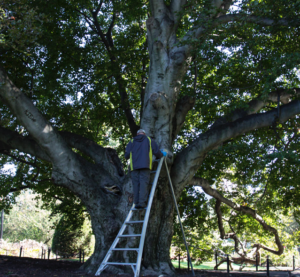 Meet the Trees: The Beeches
Meet the Trees: The Beeches
by Claire Corcoran
All but one of the beeches in our Parks are cultivars of European Beech (Fagus sylvatica). There are some striking horticultural forms represented in the collection, including the Pendula cultivar, with weeping, sweeping limbs; the Rotundifolia, with dark blackish-green leaves and a beautiful, round canopy, and the Asplenifolia, or fern-leafed variety, with lacy cut leaf margins: and the Spaethiana,which holds its deep purple color longer and emerges in the spring with a rich burgundy color. It is fitting that the sole American Beech in our parks is found on the Boston Common, just north of the Frog Pond, as one looks toward Beacon Street.
The Friends of the Public Garden cares for 14 Beech trees in the Garden, some of which date back to the original plantings during the 1870s. These older specimens are special both because of their age and size, but also their placement—three of the oldest are near the Bagheera and Tritons Baby’s fountains near the mid-block Charles Street crossing. One venerable specimen reaches out over the pathway and over the Bagheera fountain, with a large branch that has rooted in the bed beyond and is cabled to its multi-stemmed main trunk. This tree, which may be over 150 years old, is in its decline, but we are working hard to prolong its lifespan. To do so, we may need to reduce the weight of the wood in the crown, since it has significant interior rot and is vulnerable to wind damage because of its weakened wood.
One striking feature of ornamental Beech trees is their bark, which is characteristically smooth and light grey, like an elephant’s skin. Their beautiful bark is unfortunately threatened by two major concerns: vandalism by humans, and a suite of fungal diseases. Our arborist professionals use Integrated Pest Management to treat the beeches for fungal bark diseases, such as the phythopthora, cankers, and nectria. We know that maintaining these greenspaces to the highest level of excellence will help to inspire the public to love and respect them (and, we hope, refrain from vandalizing them!)
Across from the Hampshire House and Cheers, one finds a grove of Beech trees, planted in the 1980’s by two significant early friends of the Public Garden, Polly Wakefield and Westie Lovejoy. This cluster of trees, a testament to these two volunteers’ many years of service, is thriving thanks to the careful pruning, disease management, and judicious fertilizing the Friends has provided over the decades.
Into the winter season, some branches retain from the fall a few straggling, brown leaves. In Boston parks, the only trees that do this are beeches and oaks—both in the same family: the Fagaceae. The botanical word for leaves that remain on trees well into or through the winter is marcescent (from the Latin marcere, meaning enfeebled or withered). Such papery leaves hold fast until the wind rips them free, or until the emerging bud of the spring leaf pushes them off. Scientists speculate that the abscission layer, which forms in most deciduous trees to cut leaves off in the fall, is delayed for some of the leaves of beeches, resulting in a characteristically half-dressed look. In the wild, American Beeches (Fagus grandifolia) form mature forest in parts of central New England alongside Sugar Maples (Acer saccharum). These forests are strikingly beautiful as the Beech often reproduces vegetatively, through sprouts from roots or from rooted branches. This can result in a mother tree surrounded by her offspring in a circle, or, if she is dead, a perfect circle of beech trees of uniform age—a fairy circle in the forest.
I like to imagine that in 150 years a new generation of park lovers will look up at the marcescent leaves and wonder when spring will ever arrive.

